Crafting a Colorful Flower Bed for Stunning Landscaping

When it comes to enhancing the beauty of your outdoor space, few things can rival the charm and allure of a well - designed flower bed. A flower bed not only adds a splash of vibrant colors but also brings in a rich texture to your overall landscaping. In this guide, we'll explore the essential steps to create a flower bed that will transform your garden into a visual masterpiece.
First and foremost, site selection is crucial. Observe your garden throughout the day to determine areas that receive adequate sunlight. Most flowering plants thrive in full sun, which means at least six hours of direct sunlight per day. However, if you have areas that are shaded for a significant part of the day, don't worry. There are many shade - loving flowers like hostas, impatiens, and ferns that can create a lush, green oasis in those spots. Consider the proximity to water sources as well. Having easy access to water will make watering your flower bed a breeze, especially during dry spells.
Once you've chosen the perfect site, it's time to prepare the soil. Start by removing any grass, weeds, or debris from the area. You can use a shovel or a sod cutter for this task. Loosen the soil to a depth of about 12 - 18 inches. This allows the plant roots to penetrate easily and access nutrients and water. Incorporate organic matter such as compost, well - rotted manure, or peat moss into the soil. Organic matter improves soil structure, adds nutrients, and helps with water retention. Mix it thoroughly with the existing soil using a garden fork or a tiller.
Next, plan your flower bed layout. Think about the shape and size of your flower bed. Rectangular, circular, and oval shapes are popular choices, but you can also get creative and design a free - form shape that complements your garden's style. Consider the height and spread of the plants you want to use. Place taller plants at the back or center of the bed, and shorter ones at the front or edges. This creates a sense of depth and visual interest. You can also group plants with similar colors or textures together for a more cohesive look.
Now, it's time to select your plants. Choose a variety of flowers that bloom at different times of the year to ensure continuous color in your flower bed. For example, plant spring - blooming bulbs like tulips and daffodils, followed by summer - blooming annuals like petunias and marigolds, and finish with fall - blooming perennials like asters and chrysanthemums. Consider the color palette as well. Complementary colors, such as purple and yellow or red and green, create a vibrant and eye - catching display. Monochromatic color schemes, using different shades of the same color, can create a more serene and sophisticated look.
When planting your flowers, dig holes that are slightly larger than the root balls of the plants. Gently remove the plants from their containers and loosen the roots if they are root - bound. Place the plants in the holes at the same depth they were in the containers. Backfill the holes with soil and firm it gently around the plants. Water the newly planted flowers thoroughly to settle the soil and eliminate air pockets.
After planting, maintenance is key to keeping your flower bed looking its best. Water your flower bed regularly, especially during hot, dry weather. Aim to keep the soil evenly moist but not waterlogged. Mulching is also an important step. Apply a layer of mulch, such as wood chips, shredded bark, or straw, around the plants. Mulch helps to retain moisture, suppress weeds, and regulate soil temperature. Fertilize your flower bed according to the needs of the plants. Most flowering plants benefit from a balanced fertilizer applied every few weeks during the growing season.
Regularly deadhead spent flowers to encourage new growth and more blooms. Prune any damaged or diseased branches to keep the plants healthy. Keep an eye out for pests and diseases, and take appropriate measures to control them. With proper care and attention, your flower bed will become a focal point of your garden, attracting butterflies, bees, and admiration from all who see it.
In conclusion, creating a beautiful flower bed is a rewarding project that can significantly enhance the aesthetic appeal of your landscaping. By following these steps, you can design and maintain a flower bed that will bring joy and color to your outdoor space for years to come.